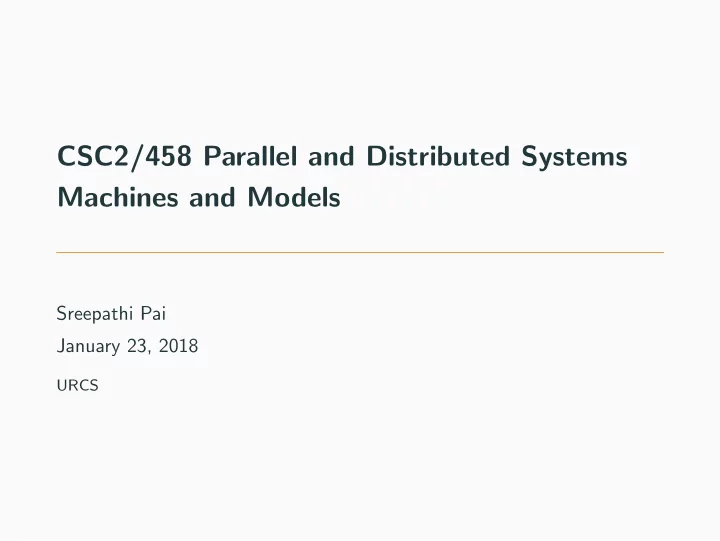

CSC2/458 Parallel and Distributed Systems Machines and Models Sreepathi Pai January 23, 2018 URCS
Outline Recap Scalability Taxonomy of Parallel Machines Performance Metrics
Outline Recap Scalability Taxonomy of Parallel Machines Performance Metrics
Goals What is the goal of parallel programming?
Scalability Why is scalability important?
Outline Recap Scalability Taxonomy of Parallel Machines Performance Metrics
Speedup Speedup ( n ) = T 1 T n • T 1 is time on one processor • T n is time on n processors
Amdahl’s Law Let: • T 1 be T serial + T parallelizable • T n is then T serial + T parallelizable , assuming perfect scalability n Divide both terms T 1 and T n by T 1 to obtain serial and parallelizable ratios. 1 Speedup ( n ) = r serial + r parallelizable n
Amdahl’s Law – In the limit 1 Speedup ( ∞ ) = r serial This is also known as strong scalability – work is fixed and number of processors is varied. What are the implications of this?
Scalability Limits Assuming infinite processors, what is the speedup if: • serial ratio r serial is 0.5 (i.e. 50%) • serial ratio is 0.1 (i.e. 10%) • serial ratio is 0.01 (i.e. 1%)
Current Top 5 supercomputers • Sunway TaihuLight (10.6M cores) • Tianhe 2 (3.1M cores) • Piz Daint (361K cores) • Gyoukou (19.8M cores) • Titan (560K cores) Source: Top 500
Weak Scalability • Work increases as number of processors increase • Parallel work should increase linearly with processors • Work W = α W + (1 − α ) W • α is serial fraction of work • Scaled Work W ′ = α W + n (1 − α ) W • Empirical observation • Usually referred to as Gustafson’s Law Source: http://www.johngustafson.net/pubs/pub13/amdahl.htm
Outline Recap Scalability Taxonomy of Parallel Machines Performance Metrics
Organization of Parallel Computers Components of parallel machines: • Processing Elements • Memories • Interconnect • how processors, memories are connnected to each other
Flynn’s Taxonomy • Based on notion of “streams” • Instruction stream • Data stream • Taxonomy based on number of each type of streams • Single Instruction - Single Data (SISD) • Single Instruction - Multiple Data (SIMD) • Multiple Instruction - Single Data (MISD) • Multiple Instruction - Multiple Data (MIMD) Flynn, J., (1966), “ http://ieeexplore.ieee.org/document/1447203/ Very High Speed Computing Systems”, Proceedings of the IEEE
SIMD Implementations: Vector Machines The Cray-1 (circa 1977): • V x – vector registers • 64 elements • 64-bits per element • Vector length register (V len ) • Vector mask register Richard Russell, “The Cray-1 Computer System”, Comm. ACM 21,1 (Jan 1978), 63-72
6 = 2 3 4 5 6 2 3 1 8 5 7 + Vector Instructions – Vertical For 0 < i < V len : dst[i] = src1[i] + src2[i] • Most arithmetic instructions
1 2 3 4 1 = min( ) Vector Instructions – Horizontal For 0 < i < V len : dst = min(src1[i], dst) Note that dst is a scalar. • Mostly reductions (min, max, sum, etc.) • Not well supported • Cray-1 did not have this
1 dst 2 3 4 0 3 1 1 1 4 2 2 src mask Vector Instructions – Shuffle/Permute dst = shuffle(src1, mask) • Poor support on older implementations • Reasonably well-supported on recent implementations
7 5 src1 g5mask src1 = ? 14 ? 6 * 2 6 6 dst 2 2 4 1 0 1 0 1 2 7 5 src2 Masking/Predication g5mask = gt(src1, 5) dst = mul(src1, src2, g5mask)
MISD - ? Flynn, J., (1966), “ http://ieeexplore.ieee.org/document/1447203/ Very High Speed Computing Systems”, Proceedings of the IEEE
What type of machine is this? Hyperthreaded Core Different colours in RAM indicate different instruction streams. Source: https://en.wikipedia.org/wiki/Hyper-threading
What type of machine is this? GPU Each instruction is 32-wide. Source: https://devblogs.nvidia.com/inside-pascal/
What type of machine is this? TPU Matrix Multiply Unit Source: https://cloud.google.com/blog/big-data/2017/05/an-in-depth-look-at-googles-first-tensor-processing-unit-tpu
TPU Overview Source: https://cloud.google.com/blog/big-data/2017/05/an-in-depth-look-at-googles-first-tensor-processing-unit-tpu
Modern Multicores • Multiple Cores (MIMD) • (Short) Vector Instruction Sets (SIMD) • MMX, SSE, AVX (Intel) • 3DNow (AMD) • NEON (ARM)
Outline Recap Scalability Taxonomy of Parallel Machines Performance Metrics
Metrics we care about • Latency • Time to complete task • Lower is better • Throughput • Rate of completing tasks • Higher is better • Utilization • Time “worker” (processor, unit) is busy • Higher is better • Speedup • Higher is better
Reducing Latency • Use cheap operations • Which of these operations are expensive? • Bitshift • Integer Divide • Integer Multiply • Latency fundamentally bounded by physics
Increasing Throughput • Parallelize! • Lots of techniques, focus of this class • Add more processors • Need lots of work though to benefit
Speedup • Measure speedup w.r.t. fastest serial code • Not parallel program on 1 processor • Always report runtime • Never speedup alone • Are superlinear speedups possible?
Recommend
More recommend